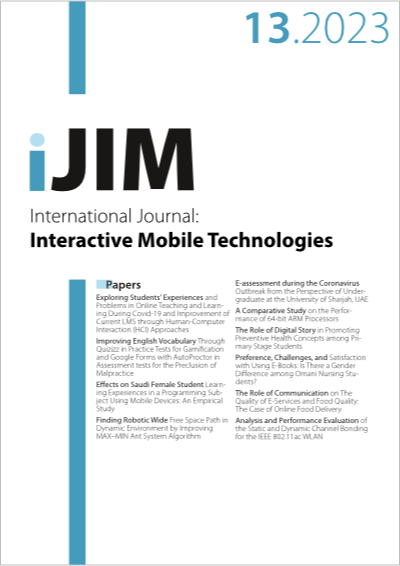Finding Robotic Wide Free Space Path in Dynamic Environment by Improving MAX–MIN Ant System Algorithm
DOI:
https://doi.org/10.3991/ijim.v17i13.41513Keywords:
Max-Min ACO Algorithm, Mobile Robot Path Planning, Obstacle Avoidance Method, and Dynamic Environment.Abstract
— This paper proposes a new obstacle avoidance method for finding an optimal path passing through wide free space based on the optimized MAX-MIN Ant System (MMAS) algorithm in dynamic environments. The proposed improvement of the MMAS algorithm occurs in two stages. The first stage analyses the environment with two modifications by proposing a new relation of pheromone trail updating to construct the consequence modified (deposited) pheromone trail update in each iteration based on adding a new parameter (clean) to calculate the possible wide empty locations. Another alteration at this level involves checking and identifying the four horizontal and vertical states. Suppose the two nodes on either side of the four diagonal nodes are barriers in the next neighbor locations. In that case, the Tight Tunnel state is then attained, and it is managed by sealing this location to prevent passing through it before the robot movement stage. Another alteration is made to the robot-moving stage by recommending a new relation of tour building probabilities to determine the best option for moving the robot from the start node through a dynamic environment that incorporates dynamic obstacles moving through free space by locating and exhibiting the ideal path via broad free space. The main outcome of the experiment simulation of the new method involves that the robot avoids going through narrow tunnels and chooses the best course through open areas to reach its destination without running into any impediments in various dynamic environments conditions. In addition, the comparison of average time occupied to find the paths by the new method reduces to 54.32% as compared with that required with the method of hybrid the basic D* algorithm with the Lbest PSO algorithm, and to 11.95% in comparison to the time occupied recorded when applying the method of the improved MAX–MIN ACO algorithm.
Downloads
Published
How to Cite
Issue
Section
License
Copyright (c) 2023 Haider TH.Salim ALRikabi; Ali Hadi Hasan, Hasanen S. Abdullah, Mohamad AB. Saleh

This work is licensed under a Creative Commons Attribution 4.0 International License.


